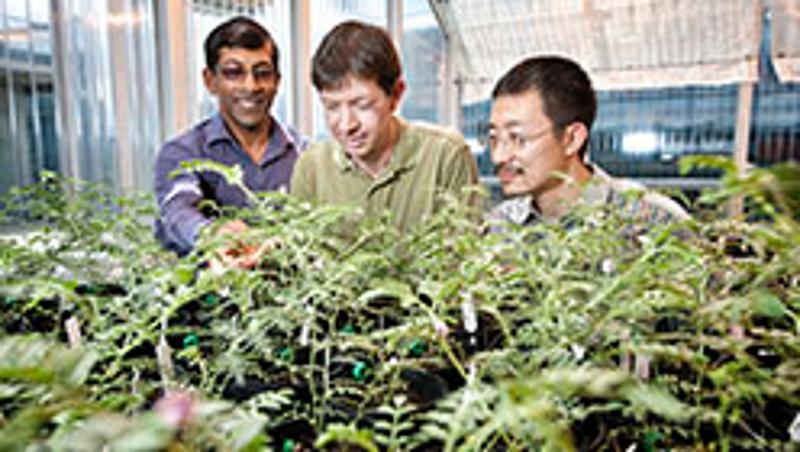
With world-first field trials of drought-tolerant mungbean plants underway, a QUT researcher says breakthroughs in chickpea and mungbean research will massively increase Australia’s potential to produce and export pulses.
QUT Centre for Tropical Crops and Biocommodities Director Professor Sagadevan Mundree said researchers were testing a novel chemical compound, developed by an Australian company, which has led to mungbean plants with stronger, deeper and more branched root systems.
He said enhanced root growth would make future crops more tolerant of drought.
Professor Mundree said mungbean producers could be growing drought-tolerant mungbeans with deeper and more robust root systems within three years.
“We have applied this new pre-treatment based on an organic chemical to mungbean seeds and conducted field trials in our lab, greenhouse and at the Department of Agriculture and Fisheries’ (DAF) Hermitage Research Station near Warwick,” he said.
“In the field, these plants produced far more seeds per gram of biomass with harvest index increasing by 20 per cent.
“This advantage was achieved despite the absence of significant moisture stress. Our current trial under shelter near Kingaroy will enable us to demonstrate what this treatment can deliver for plants when a drought stress is imposed.”
The compound has been developed by Maitland-based Plant Solutions Australia.
Professor Mundree is also developing chickpea plants that promise to be more drought-tolerant, nutritious and resistant to a fungal disease that wiped out more than a third of Queensland’s chickpea crop in 2010.
Professor Mundree said Botrytis cinera, which infects crops with a grey mould, caused havoc to Queensland chickpea crops in 2010, but researchers have found a way to potentially beat this fungus.
He said their breakthrough was thanks to a humble native grass that grows in the Australian Outback.
“This ‘resurrection’ plant tolerates extreme environmental stresses including severe drought, salinity and high temperatures,” Professor Mundree said.
“We have isolated the gene that gives the plant these death-defying characteristics.
“Over the past year we have transferred the gene to chickpea plants and in exhaustive laboratory and greenhouse tests have developed chickpea plants that as well as likely being more drought tolerant than crops currently in production, also appear to be much more resistant to Botrytis grey mold.”
Professor Mundree said iron deficiency was a major problem in the developed and developing world and his team had also increased the chickpea’s iron levels.
“QUT has a laser mass spectrometer in its Central Analytical Research Facility which we have been using to measure the micronutrient profile in chickpea seeds,” he said, “and we now know we have developed chickpea plants that produce far more nutritious seeds that are richer in iron.
“A new chickpea variety based on this innovation is expected to satisfy regulatory requirements and be available to farmers in eight to 10 years’ time.”
He said the breakthroughs were made possible through a $4.8 million Queensland government grant and that the research was important from both economic and humanitarian viewpoints.
“With the global population expected to reach eight billion within the next decade and climate change impacting heavily on countries like India where pulses are staple food crops there is a real need for the development of hardier crops that can be grown in drier climates.”
The important role pulses will play in world food security and nutrition is recognized by the United Nations which has declared 2016 International Year of Pulses.
Professor Mundree said Australian growers would also benefit from two further areas of mungbean research being conducted in partnership with DAF.
“We have jointly developed a Nested Association Mapping population tool whereby we have genetically mapped a diverse range of mungbean lines including current varieties used in cropping,” he said.
“This work will deliver new genetic knowledge on important mungbean traits and provide molecular tools and improved parents that will assist the breeding of even better mungbean varieties for Australian growers.
“The genetic resource we are developing is a world’s-first in mungbean and brings significant innovations to Queensland’s established leadership in mungbean breeding.”
Professor Mundree said soils and environmental conditions varied greatly within mungbean and chickpea growing regions. Scientists have developed a modelling tool to identify the patterns of environmental stresses that these pulse crops face across Queensland and suggest new ways to address these.
“While this tool delivers great guidance for our pulse breeders, it will also take precision agriculture to a higher level by helping growers better understand environmental risk and to more reliably deliver increased quantities of high quality pulses into demanding world markets,” he said.
Facts & figures
- Australia is the world’s largest exporter of chickpea. 90% of the domestic crop is exported to 40 countries.
- Australia’s chickpea industry is worth on average $350M per annum.
- 90% of Australia’s mungbean crop is grown in Queensland.
- Australia’s mungbean industry is worth $100M
- World population will reach 8bn within 10 years.
- Future world protein consumption will mainly be derived from pulses not livestock.
Media contact: Rose Trapnell, QUT media team leader, 07 3138 2361 or 0407 585 901 rose.trapnell@qut.edu.au




